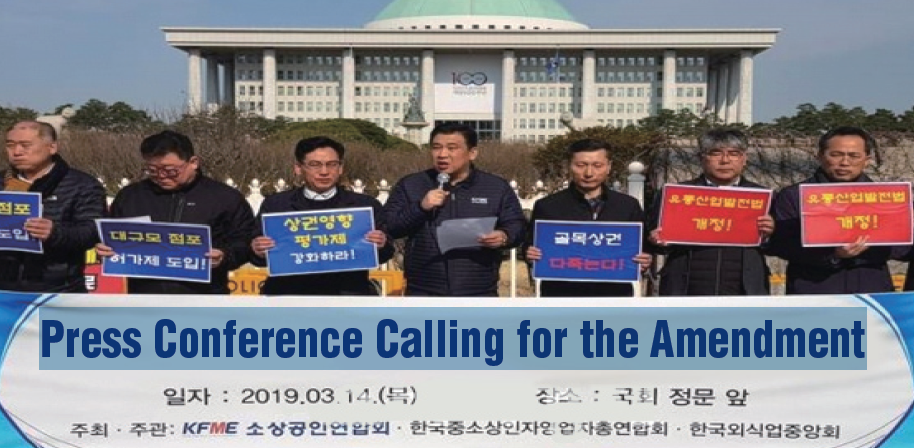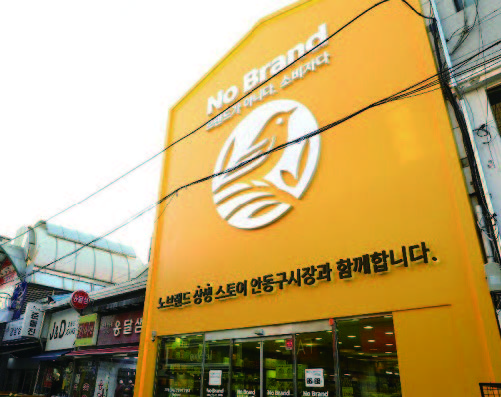In an attempt to urge the National Assembly to reform the Distribution Industry Development Act that has been hung on the hedge for more than three years, the organizations of small merchants formed a new union, The Korean Federation of Small and Medium-size Merchants, in September. The union held a demonstration in October and they warned that they were going to hold a national rally in November. In this article, the Sungkyun Times (SKT) attempts to figure out the main issues of the amendment, and its pros and cons. Furthermore, we will suggest a way as to how the Korean distribution industry should move forward.

The Status Quo of the Korean Distribution Industry
A Change in the Market Sales of the Distribution Industry
A distribution industry encompasses both commercial industries such as wholesale business, retail business, and general trade business, and physical distribution industry such as transportation, packaging and storage. The distribution industry is one of the crucial industries in the Korean economy that covers up 15% to 20% of the total employment. There are diverse distribution channels such as department stores, wholesale marts, convenience stores, supermarkets, and traditional markets in Korea. The sales of small retailers such as supermarkets and convenience stores have doubled for the past ten years. However, the “super supermarket” (SSM) which are supermarkets that are operated by big conglomerate take up more than 80% of the total sales even though the number of the SSMs is less than 15% of the total number of supermarkets. Private supermarkets that take up more than 80% of total supermarkets take a share of less than 20% of the sales and more and more of these are increasingly being replaced by super supermarkets. On the other hand, the sales of traditional markets are on a downward trend. Their sales sharply decreased from 33 trillion won in 2005 to 20 trillion won in 2015. Wholesale marts and department stores have also entered a state of stagnation. The market share of the department stores decreased from 8.9% in 2005 to 4.2% in 2015, and the market share of wholesale marts decreased from 12% in 2005 to 10% in 2015. Furthermore, according to the prospect data of Deloitte, the total market sales of the distribution industry in 2019 is expected to be 350 trillion won, and the growth prospect for each channel is 1.5% for department stores, 0.0% for wholesale marts, 8% for convenience stores, 1% for supermarkets and 15% for online shopping malls. To sum up the data of the past ten years of the distribution industry, it can be concluded that supermarkets and convenience stores are on an upward trend, while wholesales marts and department stores are on a downward trend and the traditional markets are experiencing a sharp drop.
What Is the Distribution Industry Development Act?

According to the aforementioned data, the large companies such as department stores and wholesale marts are on the downward trend. Some of the explanations for that might be the growth of the online market and the increased number of one-person households. Along with these social causes, the government invention through the Distribution Industry Development Act also affected the reduction of the market sales of large companies in the field of the distribution industry. Korea enacted the Distribution Industry Development Act in the 1990s to protect small retailers from the oligopoly of large retail companies. The Distribution Industry Development Act was legislated for the sake of boosting equity and fairness of the distribution industry and to further protect consumers and contribute to the welfare of the economy. After the enactment, the act regulated the sales of major retail companies and the regulation has been strengthened more since 2010. Starting in 2010, the act was amended to ban the entrance of large retail stores such as department stores, wholesale marts or super supermarkets within a 500 meters radius of traditional markets. In 2012, wholesale marts were regulated not to open during the early-morning until 08:00 a.m. and must have a mandatory closing day twice a month. In 2016, Kim Jong-hun, a member of the Minjung Party suggested an amendment to the act to expand the subject of regulation and to increase the number of the closing days of large retail stores, but this suggestion has not yet been accepted by parliament. According to a survey conducted by the Agency for Traditional Market Administration, 61% of the small merchants replied that the sales restriction toward large retail stores helped their sales and only 6.3% of the merchants replied that the restriction was no use for their market sales. However, as there have been more and more shopping mall complexes such as Starfield and private brand stores such as E-Mart No-Brand appearing from 2016, small retailers are protesting for their business rights in the field of the distribution industry. The union is claiming that the large retail stores are stretching out to the local distribution industry in the form of private brand stores and shopping mall complexes exploiting the unguarded boundaries of the legislation.
Main Points of the Amendment of the Act, and the Pros and Cons
A Pro Position of the Amendment
Expansion of the Subject of the Regulation
The first main point of the law of amendment is expanding the subject of the regulation from wholesale marts to shopping mall complexes and private brand stores. If the boundary of the regulation is expanded, the government could easily regulate the entrances and impose a mandatory closing day of the shopping mall complexes and private brand stores. According to statistics from the National Statistical Office, there were 72 shopping mall complexes in 2016, but the number nearly doubled to 139 in 2018. Shopping mall complexes that are much bigger in size compared to wholesales marts such as E-Mart and Homeplus and private brand stores such as No-Brand that are much smaller in size are not in the boundary of the regulation of the Distribution Industry Development Act. Therefore, companies are using this loophole to enter the local distribution market.
Strengthening the Business District Impact Assessment
The second main point of the amendment is enhancing the concreteness of the Business District Impact Assessment which is an assessment that is required to approve the emergence of large retail stores into the local commercial market. The Business District Impact Assessment evaluates the overall economic impact that the entrance of the new retailer into the local commercial market would have on the existing retailers. By reinforcing the assessment, the government can reduce the degree of the dispersion of large retail stores such as super supermarkets, wholesales marts and shopping mall complexes in a specific region. Under the current legislation, the Business District Impact Assessment did not have a concrete standard of assessment. Amended assessment includes more qualitative and quantitative analysis, analyzing both the overall impact of the local business and the impact on individual retailers in the aspect of market sales, employment, and the number of existing stores. The union is arguing that after these steps of thorough analysis and speculation of the new emergence of large retail stores, the government should approve their entry into the market place.
An Opposite View of the Amendment

The chairman of the Korea Chamber of Commerce and Industry expressed that the regulation on large retail stores was established decades ago when the stores expanded their market powers aggressively and the regulation was inappropriate for the current times as the market sales of wholesales marts and department stores are on the downturn. The two major regulations toward large retail stores are restricting the new entrance of large retailers and the mandatory closing day of the wholesales marts. According to market sales data of Deloitte, however, this regulation on large retail stores did not have much impact on protecting the small merchants or traditional markets. The regulation only boosted the number of super supermarkets that were not under the regulations by 123.5% while it decreased the number of small retail supermarkets by 27.9%. Those who are against the amendment are claiming that regulating certain kinds of distribution channels such as wholesale marts and department stores will only harm the business rights of large companies.
The Way Korean Distribution Industry Should Pursue
Encouraging the Win-win Strategy BetweenSmall Merchants and Large Retailers

The government should no longer pursue its policy focusing on regulating large retailers. Large distribution companies and small retailers should be classified as partners instead of competitors in the distribution industry. The two should cooperate and the government should encourage them to select win-win strategies. For example, the government can promote the Sangsaeng-store which is a brand new kind of distribution channel that has the large retail store design, and this store is located near the traditional market, but does not sell the kinds of items sold in the traditional market. One good example of a Sangsaeng-store is E-Mart’s “Sangsaeng” No-Brand Store that has been established near the traditional market and vitalized the market but does not overlap with the kind of items.
Various Aspects of Approaching the Solution for Vitalizing Traditional Markets
Regulating large retail stores is not a solution to revitalize the traditional market that is suffering from a sharp drop in market sales. As the consumption trend is changing at a rapid speed, when there are more mandatory holidays in wholesales marts, the consumers will use online markets, super supermarkets, and convenience stores instead of using the traditional markets. Therefore, the shift of the viewpoint of how to revitalize the traditional market is desperately needed. The government can select viewpoints of approaching the traditional market as a tool for tourism or community development. A traditional market on Renoir Street in Paris is a good example of using the traditional market as a tool for tourism. This traditional market is located on a very crowded street in Paris and there are many street performances held near the market. It is a famous sightseeing spot for travelers from all over the world. Our government should also approach the solution for Korean traditional markets from various aspects, also.
The regulations for large retail stores are inevitable in order to protect small merchants in the distribution industry. However, only pursuing the regulation on certain distribution channels no longer helps other small retailers. The small merchants should seek to increase their competitiveness in the market and the government should also enact the law that could sincerely boost the efficiency of the distribution industry
